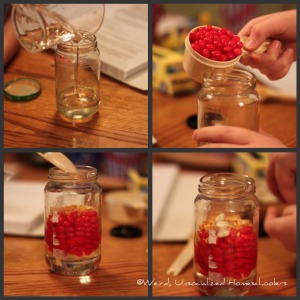Color changing goldenrod paper has been exciting students in chemistry! Imagine the enthusiasm of the first student or teacher who spilled a few drops of ammonia on a piece of yellow paper and observed it turn bright red! One can only image them exclaiming: “Super, Wow, Neat!!!”
Place the paper in a solution of household baking soda and the paper turns red; immerse it in vinegar and the red turns back to yellow! This goldenrod paper is colored with a dye that is an acid/base indicator: red in base and yellow in acid. The paper is similar to litmus paper that is blue in base and red in acid.
Even though color changing, goldenrod paper is no longer being manufactured, Educational Innovations, Inc. still has a supply and the paper is being sold in 100 sheet packages, (#SM-925). This special paper was being manufactured until June of 2008. At that time the process was changed to use a different dye that is more cost effective and better for the environment. Currently, paper of the same color, Galaxy Gold, is being offered by retail office supply stores, however, this paper uses a different dye and is not color changing.
Simple Activities With Goldenrod Paper
1. Write a “secret” message on the paper with paraffin or candle wax. The invisible message can be seen by spraying or wiping the paper with a weak basic solution e.g. ammonia (NH3 (aq)) or baking soda (NaHCO3). If you use ammonia solution, the message will disappear when the ammonia evaporates. If you use a baking soda solution, the message will remain.
2. Write a message on the paper using a cotton swab dipped into household ammonia. As the ammonia evaporates, the red message disappears.
3. Repeat Activity #2 using a cotton swab dipped into a solution of baking or washing soda. The message can be erased using vinegar (HAc) as “Yellowout .”
4. Use goldenrod paper to classify household products as acidic or basic. Solutions that turn yellow paper red are bases; solutions that turn red paper yellow are acids; and solutions that do not turn the color of either paper are considered “neutral.”
5. Tape a piece of yellow goldenrod paper to the board. Dip your hand into a shallow container of baking or washing soda and water. Then, when you press your hand against the paper, you will leave a “bloody” hand-print. Especially useful at Halloween. Compliments of Bob Becker 1985, Greenwich High School
6. Sponge the surface of a piece of goldenrod paper with a baking soda or washing soda solution and allow the wet, bright red paper to dry. Then, tape the paper to the board and press a hand that has been dipped into vinegar against the paper. The yellow hand-print will be the reverse or the “negative” of the result in activity #5. Complements of Carl Ahlers 2008, Australia
More Advanced Activities with Goldenrod Paper
7. Sponge a solution of baking soda or washing soda on a piece of goldenrod paper. Observe that the red color becomes gradually darker. Explain? Carl Ahlers has written: “Drying shifts the equilibrium in reaction 1 to the right as the H2CO3 is reduced due to the evolving of CO2 gas (reaction 2) (Le Chatelier). Subsequently more of the red Gol forms on drying. HGol (yellow) + HCO31- <—> Gol1- (red) + H2CO3 (aq) Reaction 1 H2CO3 (aq) <—> CO2 + H2O Reaction 2
8. Determine the equilibrium constant, the Ka, for this acid/base indicator. One way is to prepare a set of different pH solutions using a method of serial serial dilution on a spot plate or in small test tubes. Then, test to see at what pH the color change seems to occur for this indicator paper.
9. Make color-changing paper similar to goldenrod paper using household tumeric powder. Although tumeric is insoluble in water, in a workshop at Sacred Heart University, ca 1987, we discovered it was soluble in either ammonia or ethyl alcohol. White paper dipped in a solution of ammonia with dissolved tumeric will be dyed red which turns to yellow as the paper dries; dipped in a solution of tumeric and alcohol, the paper will remain yellow as it dries. When dry, test and observe how similar and how different the paper is from the color-changing goldenrod. Note: although this paper seems to react similar to color-changing goldenrod, the color fades much faster.
10. Prepare acid/base color changing paper using natural indicators: rose petals, purple cabbage, etc. Then determine the pKa of the paper.





